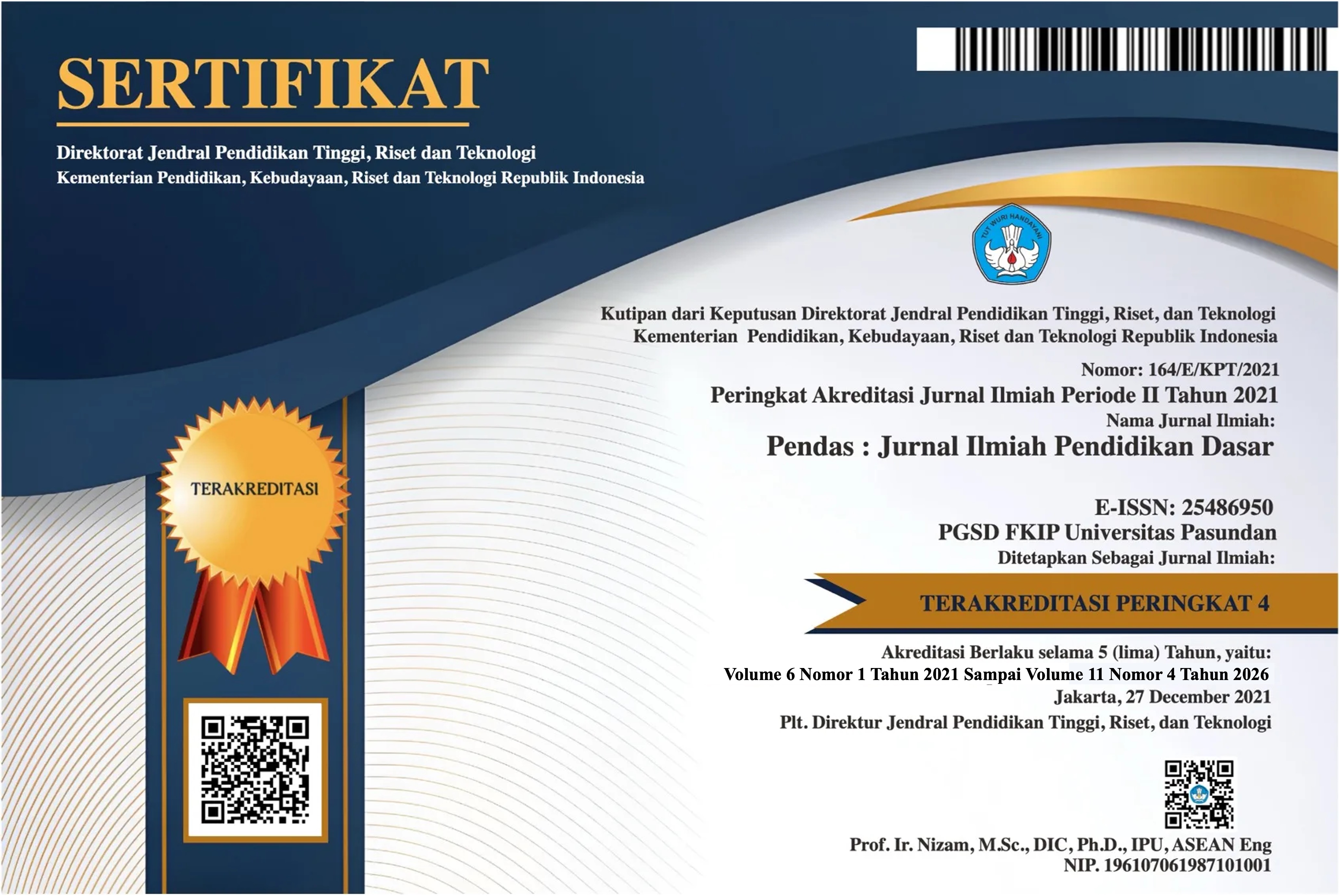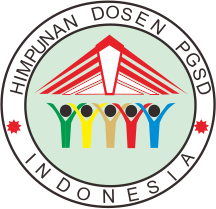LITERASI BACA SISWA KELAS AWAL DI DESA HUTABAYU DENGAN MODEL CONTEXTUAL TEACHING AND LEARNING (CTL) BERBASIS ETNOBUDAYA
DOI:
https://doi.org/10.23969/jp.v10i04.34212Keywords:
CTL; ethnoculture; reading_literacyAbstract
The aim of this research was to develop a Contextual Teaching and Learning (CTL) Model integrated with Batak ethnoculture and to test its effectiveness in improving the reading literacy of elementary school students. This study was necessary because of the students' low reading literacy levels and the lack of connection between teaching materials and the students' local and cultural context, which can hinder understanding. This development research used the Plomp model. The analysis phase included questionnaires and interviews to identify curriculum needs and relevant Batak ethnocultural richness. The CTL model based on Batak ethnoculture was designed as a learning package, including the syllabus, lesson plans (RPP), and teaching materials that featured folktales and Batak values. To test effectiveness, a quasi-experimental design was used. This involved an experimental group using the Batak ethnoculture-based CTL model and a control group using a conventional teaching model. Data was collected through reading literacy tests (comprehension, interpretation, and reflection) and student/teacher response questionnaires. The results showed that the developed Batak ethnoculture-based CTL Model met the criteria for validity, practicality, and effectiveness. The average scores on the reading literacy test for the experimental group were significantly (p<0.05) higher than those of the control group.
Downloads
References
Ahmadi, M. R., & Hairul, N. I. (2012). Reciprocal teaching as an important factor of improving reading comprehension. Journal of Studies in Education, 2(4), 153 -173. doi: https://doi.org/10.5296/jse.v2i4.2584
Ahmadi, M. R., & Pourhossein Gilakjani, A. (2012). Reciprocal teaching strategies and their impacts on English reading comprehension. Theory and Practice in language Studies, 2(10), 2053 -2060. doi:10.4304/tpls.2.10.2053 -2060.
Alderson, J. C. (2000). Assessing reading. Reading in a foreign language. Cambridge: Cambridge University Press. https://doi.org/10.1017/CBO9780511732935
Alexander, J. E., & Filler, R. C. (1976). Attitudes and reading. International Reading Association, Newark, DE. Al -Jarf, R. (2007). Developing reading and literacy in Saudi Arabia. Retrieved from ksu.edu.sa/jspui/handle/123456789/7709.
Aditya, D. S. (2021). Embarking Digital Learning Due to COVID-19: are Teachers Ready? Journal of Technology and Science Education, 11(1).https://doi.org/10.3926/jotse.1109
Bateson. 1967. “済無No Title No Title No Title.” Gastronomía ecuatoriana y turismo local. 1(69): 5–24.
Cutting, L. E., & Scarborough, H. S. (2006). Prediction of reading comprehension: Relative contributions of word recognition, language proficiency, and other cognitive skills can depend on how comprehension is measured. Scientific Studies of Reading, 10, 277-299
Khalida, Putri, and Indah Perdana Sari. 2022. “Efektivitas Metode Kupas Rangkai Suku Kata Dengan Media Kartu Huruf Untuk Meningkatkan Kemampuan Membaca Permulaan Pada Siswa Kelas I SD.” Indonesian Journal of Elementary Education and Teaching Innovation 1(2): 43.
Oki, Sukarami. 2025. “1 ), 2 ), 3 ) 1.” 10: 272–82.
Perkembangan, Sejarah, Dunia Islam, Dari Abad Kuno, and Modern Hingga Kontemporer. 2025. “Jurnal Pesona Indonesia.” 2(2): 88–94.
Safira Roesi, Rintis Rizkia Pangestika, Soyoto. 2024. “Analisis Faktor Rendahnya Kemampuan Membaca Dan Menulis Siswa Kelas II SD Negeri 2 Mranti.” Journal Binagogik 11(1): 115–22.
Saputri, Nadila et al. 2025. “K Esulitan Belajar Membaca Permulaan Siswa Kelas I SD Negeri 24 Bengkulu Tengah.” 23(3): 351–62.
Sari, N P, and S Dewi. 2025. “Pengembangan Media Magic Pocket Books Terhadap Kemampuan Membaca Permulaan Siswa Kelas 2 SDN 5 Mulyoharjo Jepara.” Jurnal Edukasi dan Riset 9(2): 112–22.
Thaharah, Ainun, Syaiful Musaddat, Lalu Wira, and Zain Amrullah. 2025. “Pengembangan Media Kartu Bergambar Berbasis Kearifan Lokal Sasak Pada Pembelajaran Membaca Dan Menulis Permulaan Siswa Kelas I SDN 25 Cakranegara.” Journal of Classroom Action Research 7(2). http://jppipa.unram.ac.id/index.php/jcar/index___________.
Tukan, Ludvina Jina Palma, Ine Sanyati, and Mariana Sada. 2024. “Implementasi Program Gerakan Literasi Sekolah Dalam Meningkatkan Minat Baca Peserta Didik Di Sekolah Dasar Inpres Habi Maumere.” JUPEIS : Jurnal Pendidikan dan Ilmu Sosial 3(1): 9–13.
Wigfield, A., Eccles, J. S., Schiefele, U., Roeser, R. W., & Davis Kean, P. (2006). Development of achievement motivation. In W. Damon & R. M. Lerner (Eds.), Handbook of Child Psychology (6th Ed), (3), pp. 933 -1002. New Jersey: Wiley Online Library. http://dx.doi.org/10.1002/9780470147658.chpsy0315.
Xia, Y. (2011a). Efficient reading in standardized tests for EFL learners: A case study of reading strategies used by Chinese English major students in TEM4. Doctoral dissertation, Kristianstad University.
Zwann, R. A., & Radvansky, G. A. (1988). Situation models in language and reading comprehension. Psychological Bulletin, 123(2), 162 -185.
Yanti, N., Suhartono, S., & Kurniawan, R. (2018). Penguasaan Materi Pembelajaran Keterampilan Berbahasa Indonesia Mahasiswa S1 Program Studi Pendidikan Bahasa Dan Sastra Indonesia Fkip Univer
Downloads
Published
Issue
Section
License
Copyright (c) 2025 Pendas : Jurnal Ilmiah Pendidikan Dasar

This work is licensed under a Creative Commons Attribution 4.0 International License.


















